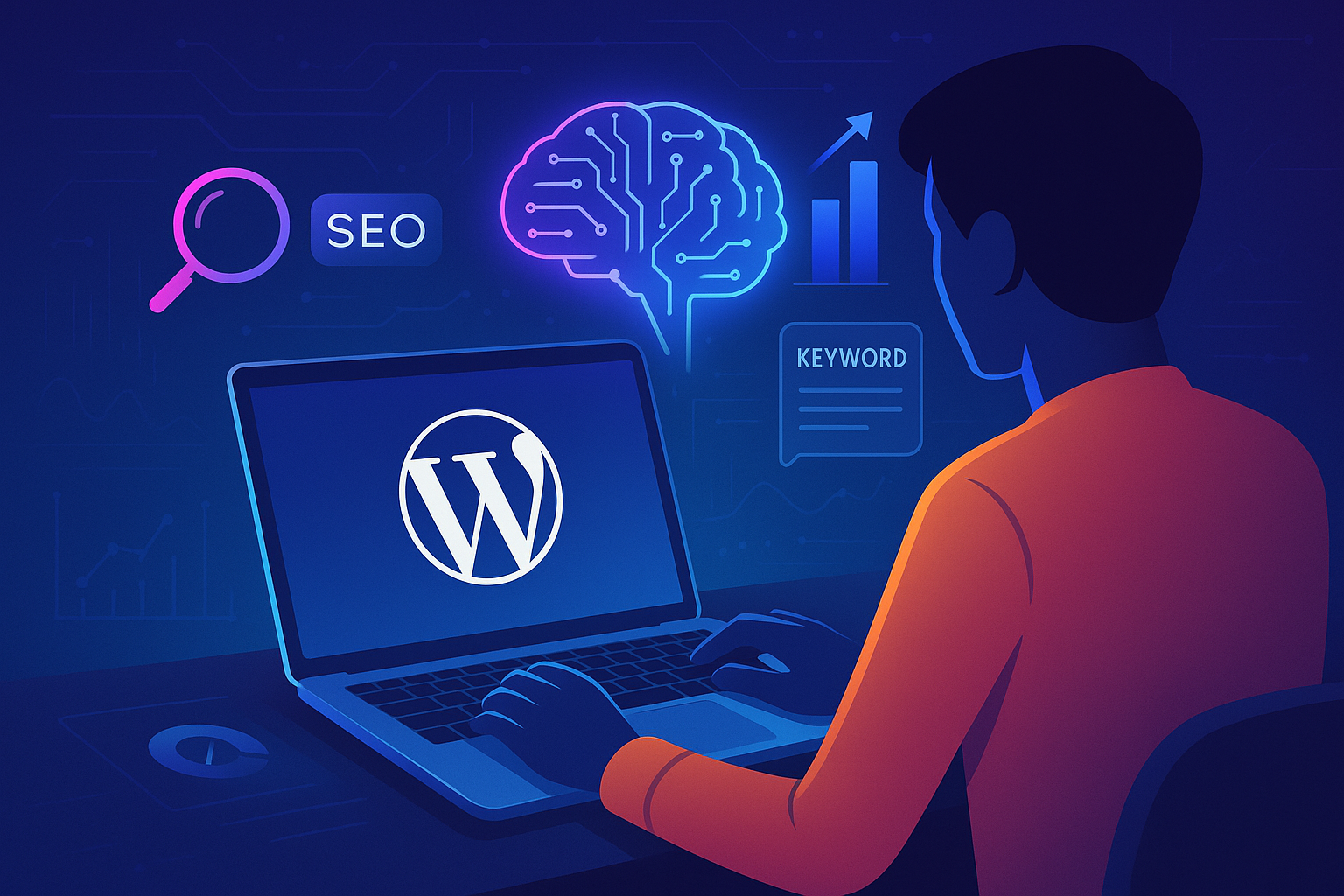Staring at a blank WordPress editor, wondering how you’ll hit “publish” this week? You’re not alone. The pressure to produce high-quality, SEO-optimized content consistently is immense.
But what if you had a co-pilot?
Artificial Intelligence has revolutionized content creation, moving from a novelty to a non-negotiable tool for savvy bloggers. By 2025, the question isn’t if you should use AI for writing, but how to use it effectively to create content that both readers and Google love.
This definitive guide will walk you through the exact process of writing a powerful, SEO-optimized WordPress blog post using AI—without sacrificing the human touch that makes your content unique.
Why Use AI for WordPress Blogging?
AI is more than just a text generator; it’s a force multiplier for content creators.
- Unmatched Efficiency & Speed: AI can generate outlines, drafts, and meta descriptions in minutes, slashing your writing time and helping you maintain a consistent publishing schedule—a key SEO ranking factor.
- Data-Driven SEO Optimization: Modern AI tools integrate directly with SEO data, offering real-time suggestions for keyword usage, content structure, and readability based on what’s actually ranking.
- Endless Idea Generation: Beat creative block forever. AI excels at brainstorming blog topics, generating compelling titles, and suggesting semantically related keywords to build a robust content calendar.
- Global Reach: Many advanced AI tools offer multilingual support, helping you translate and localize content to expand your reach and dominate new markets.
Your Step-by-Step Guide to Writing an AI-Optimized Post
Step 1: Nail Keyword Research & Topic Selection
AI needs direction. Start with solid keyword research to understand what your audience is searching for. Use tools like Ahrefs, Semrush, or Junia AI’s Keyword Analyzer to find terms with good search volume and manageable competition.
Crucially, identify the user’s search intent. Are they looking to learn (“how to”), buy (“best X for Y”), or find a website (“wordpress plugins”)? Feed your primary keyword and this intent to your AI tool to guide the entire process.
Step 2: Craft a Powerful Title & Outline
Your title is your first impression. Use your AI tool to generate a list of click-worthy options. A great title often includes:
- Your target keyword
- A number (e.g., “7 Steps…”)
- A strong adjective or power word (Ultimate, Essential, Proven)
Next, task the AI with creating a detailed outline. A good prompt is: “Create a detailed outline for a blog post titled ‘[Your Title Here]’. The primary keyword is ‘[Your Keyword]’. Include at least 5 H2 sections and 3 H3 subsections for each.” This structures your content to match what’s already ranking.
Step 3: Generate & Expand the Content
With your outline as a blueprint, instruct the AI to write section by section. This “atomized” approach yields better results than asking for a full 2000-word article in one go.
Example Prompt:
“Write a 300-word section for the chapter ‘Optimizing Meta Descriptions with AI’.
Tone: Professional and helpful.
Keyword: ‘ai meta description optimization’.
Include two practical examples.”
Pro Tip: Use the AI’s output as a sophisticated first draft, not the final product.
Step 4: Optimize for On-Page SEO in WordPress
Paste your draft into the WordPress Block Editor. Now, use an AI-powered SEO plugin like Rank Math, AIOSEO, or Yoast to refine it.
- Meta Description: Use the AI plugin to generate a compelling meta description that includes your keyword and a call-to-action.
- URL Slug: Ensure your permalink is clean and contains the primary keyword (e.g.,
/write-wordpress-post-with-ai). - Headings: Use your AI tool to suggest LSI keywords to include naturally in your subheadings (H2s, H3s).
- Internal Linking: Plugins like AIOSEO’s Link Assistant can analyze your content and automatically suggest relevant internal links to boost SEO.
Step 5: Enhance Readability & Engagement
Google rewards content that provides a great user experience. Use the built-in analysis in your SEO plugin to:
- Shorten long sentences.
- Break up large walls of text into shorter paragraphs (2-3 sentences).
- Add transition words to improve flow.
- Use bulleted lists (like this one!) for scannability.
Step 6: Add The Essential Human Touch (This is Key!)
This is the most critical step. AI is your assistant, not your replacement. Edit, fact-check, and personalize the content.
- Add Personal Anecdotes: Weave in your own experiences and stories.
- Inject Expertise: Include unique data, insights, or quotes that the AI couldn’t know.
- Fact-Check Everything: AI can sometimes “hallucinate” or present outdated information. Verify all facts and stats.
- Final Proofread: Read it aloud to catch awkward phrasing and errors. Tools like Grammarly are great for this.
Top AI Tools for WordPress SEO Writing in 2025
| Tool | Primary Use | Key WordPress SEO Features | Best For |
|---|---|---|---|
| Junia AI | Content Creation & SEO | Integrated keyword research, SERP analysis, SEO optimization, long-form content | All-in-one content and SEO solution |
| All in One SEO (AIOSEO) | SEO Plugin | AI Title & Meta Description generator, Content SEO analyzer, Link Assistant | Enhancing your existing WordPress SEO workflow |
| Surfer SEO | On-Page Optimization | Data-driven Content Editor, SERP analyzer, granular structure recommendations | Data-centric creators who want a blueprint |
| Frase | Content Research & Writing | AI-generated content briefs, SEO optimization, content analysis | Content teams focused on strategy and scaling |
| WordLift | Structured Data & SEO | Automatically adds schema markup, analyzes content for topics and entities | Improving technical SEO and knowledge graph visibility |
Pro Tips for Optimizing AI-Generated Content
- Comprehensive Coverage: Use AI to analyze top-ranking pages. Ensure your post is more detailed, informative, and valuable than the competition. Google loves “top-tier” content.
- Image Optimization: Use AI to generate descriptive file names (e.g.,
ai-wordpress-seo-tips.webp) and alt text that includes your keyword where relevant. This drives image search traffic. - Build E-E-A-T: Demonstrate Experience, Expertise, Authoritativeness, and Trustworthiness. Use AI to draft, but use your expertise to add commentary, cite authoritative sources, and provide genuine value that only a human can.
The Future is a Human-AI Partnership
The future of WordPress blogging isn’t about AI replacing humans; it’s about humans leveraging AI to work smarter. We’re moving towards:
- Hyper-Personalized Content: AI will tailor content in real-time to individual user behavior.
- Voice Search Optimization: Crafting natural-language content that answers conversational questions.
- AI-Powered Content Distribution: Tools that not only create content but also automate its promotion across social and email channels.
Conclusion: Write More, Stress Less, Rank Higher
Writing SEO-optimized WordPress blog posts with AI is the ultimate productivity hack for 2025. By letting AI handle the heavy lifting of research, drafting, and technical optimization, you free up your most valuable asset: your creativity and expertise.
Embrace AI as your collaborative partner. Use it to streamline your workflow, enhance your SEO, and ultimately create better content for your audience. The result? You’ll publish more consistently, rank higher, and finally break free from the tyranny of the blank page.
What’s your biggest challenge when using AI for writing? Share your thoughts in the comments below!




